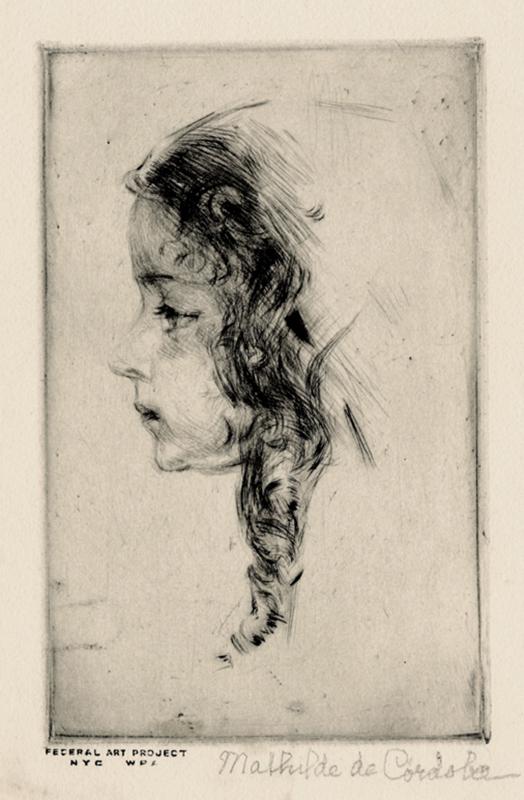
19th, 20th & 21st Century Fine Prints
707-546-7352 · fax 707-546-7924 · web: www.annexgalleries.com · email: artannex@aol.com
Untitled (Profile of little girl) (WPA) by Mathilde de Cordoba

Untitled (Profile of little girl) (WPA)
Mathilde de Cordoba
Untitled (Profile of little girl) (WPA)
Mathilde de Cordoba
1875 - 1942 (biography)Despite her immense talent and prolific output, the growing reputation of New York artist Mathilde De Cordoba - which had reached Paris and London by the 1920s - ended around 1925 when she quickly lost most of her eyesight, likely due to eyestrain and the harsh chemicals used in the etching process. After a handful of years she was able to receive an operation to correct her sight, but by then the Great Depression had set in and opportunities to network, exhibit, or sell at a gallery were fewer and farther between.
When the Works Progress Administration (WPA) was formed and the Federal Art Project (FAP) arrived in New York City, de Cordoba was hired as a printmaker. Now in her 60s, she restarted her career and found some measure of success once more. She continued to make prints until her death in 1942; the New York FAP published her final etching in 1943.
Mathilde De Cordoba was born between 1875 and 1880 in New York City (dates vary with publications) to French and Cuban parents. Coming from a family that fostered interest in the arts, she and her brother, Pedro, were exposed to visual and performance art from an early age; Pedro himself would go on to become a star of the stage and screen.
Early in her art career De Cordoba studied under Kenyon Cox at the Art Students League and with William Merritt Chase at Shinnecock Summer School; later in life, she would return to the League to broaden her studies with Hans Hoffman and Andre l'Hote. She was a member of the National Association of Women Painters and Sculptors, the New York Water Color Club (exh. November of 1898), New York Women's Art Club (exh. April of 1906), the Engraver Printers of London, and the Societe de la Gravure en Couleur in Paris.
She was also associated with the Byrdcliffe Arts & Crafts Colony near Woodstock, NY. Between 1908 and 1913 she lived, studied, and exhibited in Europe and Britain, participating in Paris Salons and hanging a solo exhibition in 1910 at the Dowdeswell Gallery in London. Several of her works were purchased by the Paris government and the New York Public Library.
Just as she was establishing an interational reputation, an illness, possibly brought on by the continued use of etching inks and acids, partially blinded her. It took several years until an operation restored her sight and she was able to return to working; by then, her career had stalled. She continued despite this setback and from the 1930s until her death in 1942 she worked with the WPA as a printmaker. She was especially known for her portraits, and many of them are included in the collections of the Metropolitan Museum of Art, the National Gallery of Art, and the New York Public Library.
Mathilde deCordoba died in Valhalla, New York, in 1942.
